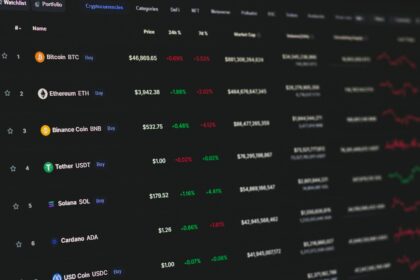To evaluate trading conditions effectively, focus on the order book’s volume distribution around the current price. High availability of buy and sell orders near this price level means smoother transactions with minimal slippage. This ensures that large trades won’t drastically shift value, maintaining stable exchange rates.
Volume concentration in bids and asks reveals how easily assets can be exchanged without impacting prices significantly. Thin layers of offers indicate low turnover capacity, which increases the risk of sudden price swings during sizable trades. Monitoring these levels helps traders choose optimal entry and exit points for their positions.
Price movements often reflect the balance between supply and demand at various levels of interest. By studying cumulative order sizes and their placement, one can anticipate potential resistance or support zones. This insight allows better timing decisions and improved risk management throughout trading sessions.
Understanding Crypto Liquidity: Market Depth Explained
Liquidity in cryptocurrency trading is best evaluated through the concept of order book thickness, which directly impacts price stability and execution speed. A high volume of buy and sell orders clustered near the current price allows for larger trades without significant slippage. For example, Bitcoin on major exchanges often exhibits deep order books with thousands of BTC at various price levels, ensuring minimal price impact during transactions.
Conversely, thin order books with low trade volume can cause rapid price fluctuations even on relatively small trades. This phenomenon happens frequently with lesser-known altcoins or tokens listed on low-liquidity platforms, where executing an order can shift the market price considerably. Recognizing these dynamics helps traders anticipate potential risks associated with entering or exiting positions.
Order Book Structure and Its Role in Pricing
The order book displays outstanding limit orders sorted by price levels–bids represent buy interest while asks indicate sell interest. The cumulative volume at each level reveals how much asset supply and demand exists around certain prices. When a market order arrives, it consumes available liquidity starting from the best bid or ask, pushing prices up or down depending on trade direction.
For instance, if a trader places a market buy order larger than the available sell volume at the lowest ask, the remaining part fills higher-priced asks, causing upward pressure on the executed average price. This interaction between volume and pricing underlines why assessing order book composition is critical to understanding potential execution costs beyond simple spot prices.
Volume Distribution as an Indicator of Trading Strength
Examining trade volume alongside order book data offers additional insights into asset activity and participant interest. High trading volumes generally correlate with tighter spreads–the difference between highest bid and lowest ask–which facilitates smoother transaction flow. In contrast, assets with sporadic or low volume may experience wider spreads leading to inefficient pricing mechanisms.
A practical case study involves Ethereum’s trading pair against USD on several exchanges where high volumes ensure consistent bid-ask spread narrowing throughout active periods. This behavior contrasts sharply with newer tokens whose sporadic volumes create unpredictable execution environments that can deter traders seeking reliable entry points.
Implications for Trading Strategies and Risk Management
Traders aiming for optimal entry or exit should analyze liquidity profiles before initiating orders. Utilizing limit orders near areas of concentrated volume helps minimize slippage and unexpected price deviations. Additionally, monitoring time-weighted average prices (TWAP) or volume-weighted average prices (VWAP) can assist in breaking large transactions into smaller chunks aligned with prevailing liquidity conditions.
For example, institutional players often use algorithmic trading tools that factor in real-time depth data to slice orders strategically across multiple exchanges thereby reducing market footprint while achieving target fills close to benchmark prices.
The Effect of Market Conditions on Execution Quality
Volatility spikes typically reduce effective liquidity as participants withdraw resting orders fearing adverse movements. During such phases, even assets usually characterized by robust activity may see sudden widening spreads and increased slippage risk. Understanding this cyclical behavior enables traders to adjust tactics accordingly–perhaps postponing sizable trades until normal conditions resume or employing hedging instruments to mitigate exposure.
An illustrative scenario occurred during major announcements affecting Bitcoin’s regulatory outlook when liquid markets temporarily thinned out causing sharp intraday swings despite historically deep pools of buyers and sellers.
Tools for Real-Time Analysis and Practical Application
A range of analytical platforms provides detailed visualization of book data including aggregated volumes at discrete price levels alongside historical trends in liquidity shifts. Integrating these tools into daily routines empowers traders to identify favorable moments for execution based on quantitative criteria rather than intuition alone.
- Order book heatmaps: Color-coded visual summaries highlighting clusters of resting orders help quickly spot liquidity pockets.
- Spread trackers: Continuous measurement of bid-ask differentials indicates instantaneous transaction cost estimates.
- Volume profiles: Statistical breakdowns showing how much asset traded within specific price ranges over set intervals aid pattern recognition.
Cultivating familiarity with these resources builds confidence in navigating complex trading environments where precision timing aligned with liquidity considerations significantly influences profitability outcomes.
How to Read Order Books
Order books display real-time lists of buy and sell orders, providing crucial insights into asset pricing and trade volume. To interpret them accurately, focus on the bid and ask sections: bids show buyers’ prices and quantities, while asks reveal sellers’ intentions. Observing these helps assess trading activity and price levels where significant interest clusters.
Volume figures next to each price point indicate how many units participants are willing to transact at specific rates. Higher volumes near particular prices suggest strong participation, making those levels more likely to influence future transactions. This interplay between price and volume shapes transaction dynamics.
Key Elements for Analyzing Order Books
The first step is identifying concentration points where large orders accumulate. These clusters act as temporary barriers or support zones affecting price movement. For example, if many sell orders align closely above the current price, it may slow upward momentum by creating resistance.
Conversely, substantial buy orders stacked below the current trading rate create a safety net, reducing rapid declines. Traders often monitor such imbalances to anticipate short-term trends or reversals within a trading session.
Order book depth shows available liquidity at various prices along with cumulative volume data that reflect overall market commitment. Platforms sometimes visualize this as a graph with distinct curves for bids and asks, enabling quick assessment of supply-demand equilibrium around prevailing rates.
Consider a scenario where the ask side exhibits thin volume across multiple price levels while bids cluster densely near the current level; this setup signals limited selling pressure but solid buying interest supporting prices. Understanding these nuances can improve timing decisions for entry or exit points.
Impact of Spread on Trades
The difference between the highest bid and lowest ask prices, known as the spread, directly affects trade efficiency and cost. Narrow spreads indicate a tighter pricing gap, which typically results from higher volume and substantial order book entries near the current price level. This compresses transactional costs for participants by minimizing slippage during execution. Conversely, wider spreads signal scarce orders clustered away from the mid-price, increasing expenses for traders as they must accept less favorable prices to complete deals.
Price gaps also influence how quickly orders fill and can affect volatility in trading pairs with lower activity. For example, tokens with limited turnover often display broader spreads due to thinner order books and reduced buy-sell interest. This causes larger discrepancies between quoted prices and actual trade execution levels, pushing traders to pay premiums or discounts that erode potential profits. A practical approach involves monitoring recent volume trends alongside spread fluctuations to identify optimal entry points where transaction costs remain manageable.
Technical analysis of order book data reveals that depth concentration close to mid-market price mitigates spread impact significantly. When sizable bids and asks populate narrow price intervals, even high-volume trades experience minimal adverse price movement. For instance, stablecoins paired with major currencies frequently exhibit this behavior due to robust liquidity pools maintained by market makers. In contrast, emerging altcoins might show sparse depth layers that force market takers into unfavorable fills when executing large orders.
Traders can strategically reduce spread-related losses by splitting orders into smaller portions or timing executions during periods of increased activity. Algorithmic strategies often leverage these principles by slicing volumes across multiple price levels detected within real-time book snapshots. Additionally, using limit orders positioned inside the spread can capture incremental gains while avoiding immediate unfavorable fills typical in volatile conditions. Continuous evaluation of spread dynamics combined with volume distribution offers valuable insights for optimizing trade performance across diverse digital asset pairs.
Role of Market Makers
Market makers provide continuous bid and ask quotes, ensuring that trading pairs maintain sufficient volume on both sides of the order book. By doing so, they directly contribute to tighter spreads between buy and sell orders, which stabilizes the price and enhances overall transactional efficiency. This constant presence helps prevent dramatic price swings caused by thin order books or sudden large trades.
Their activity increases the availability of assets for immediate purchase or sale, effectively improving the accessibility and smoothness of transactions. For example, in a decentralized exchange where natural participants may be sporadic, market makers fill this gap by offering liquidity through algorithmic strategies that adjust their orders dynamically based on real-time trading data.
A key function of these participants lies in managing inventory risk while maintaining balanced exposure. They use various quantitative models to estimate optimal order sizes and price levels, considering factors like expected trading volume, volatility, and current order flow. This strategic placement within the order book deepens the layers available to traders beyond just the top bids and asks.
The robustness of a platform’s transactional ecosystem often hinges on how effectively market makers operate. For instance, during periods of heightened activity or sudden news announcements affecting asset valuations, their presence can mitigate slippage by absorbing large orders without causing disproportionate shifts in quoted prices. This dynamic adjustment fosters confidence among retail traders who might otherwise hesitate due to potential unpredictability.
An illustrative case can be seen with professional entities deploying automated bots that continuously monitor price movements across multiple exchanges. These bots arbitrage inefficiencies by placing offsetting buy and sell orders that maintain equilibrium within individual books and across venues. Such mechanisms not only support consistent liquidity but also enhance fair pricing benchmarks critical for accurate market assessment.
In summary, entities serving this intermediary role help construct a stable environment where participants encounter minimal friction executing trades at predictable rates. Their contribution is quantifiable through metrics such as reduced bid-ask spreads, increased cumulative order book size, and smoother transaction flows–indicators vital for both novice investors seeking reliable entry points and institutional actors requiring assured execution quality.
Measuring Liquidity with Volume
Volume represents the total quantity of assets traded within a specific period and serves as a primary indicator for assessing liquidity in cryptocurrency trading. High trading volume typically signals that many participants are actively buying and selling, which facilitates smoother transactions and reduces the impact of large orders on price fluctuations. For example, Bitcoin often shows daily volumes exceeding tens of billions of dollars, indicating a robust environment where trades can be executed rapidly without significant slippage.
Conversely, low volume indicates fewer participants and thinner order books, resulting in less efficient price discovery and wider spreads between bid and ask prices. When analyzing tokens with lower capitalization or newly launched projects, traders frequently observe sporadic volume spikes followed by prolonged stagnation. This irregularity can cause abrupt price changes even on relatively small orders, emphasizing why volume is critical for evaluating asset tradability beyond mere price movements.
The Relationship Between Transaction Volume and Price Stability
Examining historical data reveals that assets with consistently high turnover tend to exhibit more stable pricing patterns due to enhanced market resilience. A practical case study comes from comparing Ethereum’s average daily volume against smaller altcoins: Ethereum’s substantial transaction flow ensures that large buy or sell orders impact its price less dramatically than those same orders would affect less liquid coins. This dynamic reflects how increased activity buffers against volatility by spreading order execution across numerous counterparties.
Additionally, volume metrics combined with order book snapshots provide deeper insight into real-time liquidity conditions. While the visible depth illustrates available buy and sell offers at various prices, volume confirms whether these levels translate into actual trade execution frequency. For instance, an order book may show ample bids near current price points, but if trade volume remains minimal over time, those bids might not materialize into completed transactions promptly.
For traders aiming to enter or exit positions efficiently, monitoring rolling volume averages alongside instantaneous transaction rates is advisable. Tools such as moving averages on volume charts smooth out noise caused by isolated events and reveal underlying trends in asset circulation. These analytical techniques assist both beginners seeking reliable entry points and experienced participants optimizing timing based on market behavior patterns.
A comprehensive evaluation requires integrating volume data with other indicators like spread size, order book composition, and recent trade history. This multifaceted approach helps confirm whether apparent market activity genuinely supports desired trade sizes without significantly affecting prevailing prices. Understanding this interplay empowers users to make informed decisions backed by quantitative evidence rather than solely relying on anecdotal observations or superficial price changes.
Slippage Causes and Solutions: Technical Insights and Future Directions
Mitigating slippage requires prioritizing order book breadth and transaction volume to ensure price stability during trade execution. Traders should target assets with substantial bid-ask spread tightness and significant token turnover, as shallow order books amplify price deviations when large orders hit limited offers.
Advanced tools such as limit orders and algorithmic trading strategies can dynamically adapt to fluctuating supply-demand imbalances, reducing unexpected price impacts. Additionally, decentralized exchanges increasingly implement mechanisms like liquidity aggregation and dynamic fee adjustments to compensate for volatility-induced slippage.
Key Technical Takeaways
- Order book scale: Deeper inventory of buy/sell orders cushions against abrupt price swings caused by sizable trades.
- Trade volume correlation: High transaction throughput maintains tighter spreads, minimizing slippage risk during execution.
- Price impact modeling: Real-time analytics estimating potential slippage help traders optimize order timing and size.
- Liquidity provider incentives: Protocols encouraging diverse market makers improve overall capital availability, stabilizing pricing layers.
For instance, executing a $100,000 trade on an exchange with a thin ledger often results in worse average prices compared to splitting the same sum into smaller increments on venues exhibiting robust supply chains. Tools that visualize depth charts empower users to anticipate these challenges proactively.
The trajectory of transactional efficiency points toward enhanced interoperability between platforms, leveraging off-chain order routing combined with on-chain settlement. Such hybrid designs promise reduced friction and better alignment between executed prices and quoted levels, shrinking slippage footprints further.
Continued refinement in automated market maker protocols–particularly those integrating adaptive bonding curves responsive to real-time activity–will contribute significantly to smoothing out price fluctuations related to liquidity gaps. As ecosystem maturity rises, participants can expect increasingly predictable execution outcomes supporting more sophisticated investment tactics without excessive cost overruns from slippage events.





